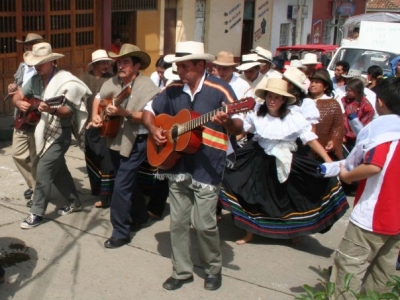Fómeque has an abundant folklore, based on customs and places where daily experiences unfold.
LEGENDS:
Numerous legends frame the life of the Fomequeña community. It was common to hear from the lips of the elders the narrations from every corner of the municipality. These were sometimes scary, but always moralizing. Fortunately, there was a writer who collected all this popular knowledge: the academic José Antonio León Rey, which has allowed to extend this knowledge over time and the town has a wealth of traditions, legends and songs. Among the legends stand out: The two compadres, The Bells of Fómeque, the Headless Horse, The Treasures of the Páramo, Quebradahonda, The Wandering Jew and El Camino del Tahúr.
Most of these legends appear compiled in the book Earth Bewitched of that writer and others like Guayacundo. Haunted Earth appeared in 1942 and became a treasure, but because of its interesting content, it disappeared without hope of a new edition. Fortunately 50 years later - in 1992 - an official from the province, Dr. José Ignacio Flórez, became interested in the work and managed to get the Lottery of Cundinamarca to sponsor a second edition so that many families had the opportunity to acquire this treasure of legends.
The bell of the devil
Many years ago, at the time of the conquest and colonization, the parish priest of the newly founded town of Fómeque in eastern Cundinamarca, brought to his parish a valuable silver bell that was cause for joy in the nascent village.
The residents went to receive music and gunpowder to their pastor with the bell, which arrived at the town after multiple hardships, among them, the passage through the paramo of Cruzverde. The silver bell, the new pride of Fómeque, was left by the parish priest in the plaza to bless her the next day and place it in the bell tower that had been made in the colonial chapel.
The evil god, called Fu by the Chibchas and Demon, Patas or Mandingas by the Spaniards, impressed by the arrival of his enemy the silver bell, with which the Christians remembered his worship and devotion, and knowing that he was not yet blessed with the sacred ritual, stole it in the late hours of the night and hid it in the closest hill of the Cordillera de los Órganos, located southeast of Fómeque.
This mountain range has rocks in fantastic shapes, which sometimes look like the ruins of gigantic castles and others, the remains of monstrous organs, whose trumpets were defiant to the skies. For the Fomequeños it is a region of mystery.
The theft of the bell filled the town founded by Oidor Visitor Luis Enríquez with consternation in 1600. The people initially blamed the Ponta Indians, and even blamed some Castilians avid for gold and silver. Fómeque in Chibcha means "Forest of foxes": the god Fu or Fo, the Muisca devil, was represented by a fox.
For the Fomequeños, however, the idea remained that the silver bell had been stolen by the devil "Fo", the only one capable of stealing a bell to call the devotion of the Christian faithful. Tradition has it that a Good Friday at 3 o'clock in the afternoon, a traveler crossing the moors that surround the Cordillera de los Órganos, felt the ringing of the silver bell, followed by a satanic laugh that came from the rocks and put the Traveler to run with fear until you reach Fómeque. When she told the people what happened, everyone was surprised, and since then they believe that the silver bell will be found by anyone looking for her in the páramos de los Órganos, a Good Friday at three o'clock in the afternoon.A couplet of Fómeque relates the devil to the bell; it says so:
«El diablo te lleve a tí cual se llevó la campana, sí no vinieres morena. a visitarme mañana»".
FESTIVITIES:
Eighth of December

The feast of the Immaculate Conception, patron of Fómeque, is commemorated - the Fomequeños have special devotion to the Queen of the Skies under this dedication - on the eve of the Eight, the luminaries in the fields, the gunpowder and the hoisting of the blue flag are abundant and white as well as the prayer of the holy rosary in family.
Feast of the Virgin of Carmen
He is praised as the protector of the drivers. His party is celebrated with parade and blessing of the vehicles, after a large attendance at the mass. The drivers organize sports competitions for this day.
Feast of San Isidro
San Isidro is considered an intercessor for prosperity in the harvest and for the benefit of the rains. The farmer usually invokes it before beginning his agricultural work.
Outside the popular festival of the San Isidro Fair, there is a day for religious celebration, a day when the peasants prostrate themselves before his image, accompany him in the procession and offer him the best of their crops.






